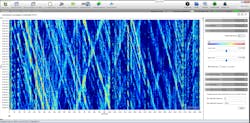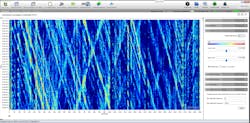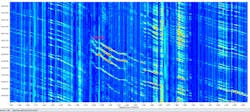High Resolution Traffic Monitoring at the Speed of Light
Managing the impact of rapidly increasing traffic volumes and minimizing congestion and journey times on existing road infrastructure is a significant issue for the Georgia DOT (GDOT).
In the greater Atlanta area, the challenge is particularly acute. Highway traffic volume in the region is among the highest in the U.S. with a 2019 Urban Mobility Report finding that ranks it sixth for traffic congestion with drivers spending an average of more than three days per year stuck in traffic.
Access to accurate and timely information on the current traffic situation is critical for GDOT to maintain traffic flow and make rapid and informed decisions regarding evolving situations. As such, GDOT continually explores innovative technologies to improve efficiency from a traffic management perspective.
This exploration includes constant evaluation of alternative sources of traffic information, including connected devices such as in-car sensors, mobile devices, or other floating-point sources focused on facilitation of route-wide coverage. However, these technologies have their drawbacks in terms of high latency, low sample rate, and limited functionality for some traffic monitoring applications.
Often new and innovative technology for traffic sensing offers additional capabilities and functionality. However, the potential high life cycle costs associated with roadside sensor technologies can require a compromise between accuracy and availability of key traffic flow information and the density of roadside sensor deployment.
It is much less common that innovative technology delivers both a step change in performance and significant operational advantages including rapid implementation over extended routes. It is against this backdrop that GDOT first began to investigate the use of fiber-optic sensing technology as a means of obtaining improved traffic information.
To this end, GDOT has engaged in a six-month demonstration agreement with OptaSense to pilot a sensor that reads fiber-optic light patterns to collect traffic data. This technology—called OptaSense Traffic Monitoring Solutions (TMS)—converts existing GDOT roadside fiber optics into an intelligent traffic sensor. A high frequency light enables it to detect vehicles (or objects) in specific lanes on the roadway. It also determines speeds by sensing vibrations, which offers new possibilities for high-resolution traffic speed detection.
GDOT deployed the OptaSense technology along 20 miles of I-20 from I-285 to the Downtown Connector in Atlanta to evaluate the system in real-time. If the results of our evaluations are successful, we believe this could be a way to simplify our intelligent transportation system (ITS) deployments moving forward.
The single OptaSense sensor, which is located at ground level, could possibly replace the department’s 60 sensors that are located overhead along the route, meaning this innovation could represent a fraction of the life cycle cost of traditional point sensor alternatives.
Fiber optic sensing converts spare capacity (e.g., a single dark fiber) within existing roadside fiber optic cables into a distributed traffic sensor capable of delivering highly accurate and timely traffic flow and incident detection information from the entire monitored road.
Using a technique known as distributed acoustic sensing, a single deployment of the technology can monitor up to 50 miles of highway. The sensing equipment (designed and manufactured by OptaSense) is typically located in a communication hub building where the required power, environmental control, and access to the fiber is available.
The roadside fiber is then converted into an array of intelligent sensors by laser technology that detects the noise and vibration from passing vehicles. This is converted by software algorithms into key traffic flow indicators at 165-ft intervals along the fiber. The technology provides a very high-resolution view of traffic speed variations along the highway.
The key objective of the pilot was to evaluate whether fiber optic sensing could be a viable solution for providing accurate traffic flow volume, occupancy, and speed information, allowing the department the option to retire existing legacy detection devices. To meet this objective, specific attention was given to the ease of installation, detection accuracy, and availability of accurate information from the entire monitored road throughout the duration of the six-month evaluation. GDOT is comparing the data registered by OptaSense, with information from the legacy system.
Initial results have exceeded expectations and clearly demonstrate the potential of a fiber optic sensing solution to deliver accurate and timely traffic flow information using existing roadside fiber as a traffic sensor. Installation and calibration of the system was completed within one month of the project start with zero highway closures or need for on-site construction. Safety of roadside workers is always a concern so not having workers go up in bucket trucks on the side of busy roads was also a consideration.
The implemented solution successfully converted an existing roadside fiber optic cable into an array of virtual speed sensors capable of delivering accurate traffic speed information at 165-ft intervals, updated every second, from both nearside and farside lanes—eight traffic lanes in total—using a single roadside fiber.
In addition to effectively equipping eight lanes of traffic with high-resolution speed sensors, the system has provided accurate traffic counts at key locations where fiber optic road crossings existed.
By leveraging existing fiber optic cable and avoiding the need for construction and traffic disruption, GDOT has been able to equip a significant length of highway very quickly. The pilot project results have shown comparable accuracy to more traditional roadside sensors and yielded a new capability to understand speed variations at a highly granular level along Georgia’s highways.
The success on I-20 is encouraging. Projects like this lay the foundation for adopting fiber-optic sensing technology for high-resolution speed measurement statewide and open the possibility to combine this high-quality source of traffic information with other data sources to provide a complete picture of variations in transportation conditions and travel demand on key highways.
GDOT currently has over 350 center-line miles of fiber optic cable deployed in the metro Atlanta area with plans to expand coverage statewide. The ability to convert existing fiber-optic cable into high resolution speed sensors is extremely valuable as it overcomes the limitations of existing sensors and allows prior investment in fiber optics to be leveraged for a new purpose—adding new functionality with minimum additional investment.
The technology can also be applied to arterial roads where the possibility exists of combining automated traffic signal performance measures from traffic controllers with high-resolution speed data to provide a new level of insight and understanding into the actual performance of the road network and driver behavior.
GDOT’s investments in innovative technology such as OptaSense allow the department to leverage prior investments like fiber optic cable and enable rapid deployment of new technologies such as high-resolution traffic sensors at a fraction of the cost associated with conventional roadside sensors. Moving forward, the department also intends to assess options to integrate the OptaSense data into its existing traffic management center systems.


